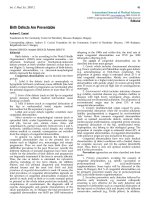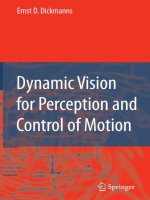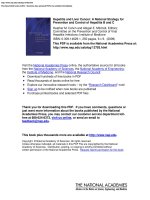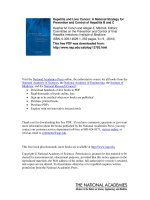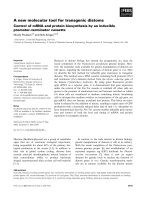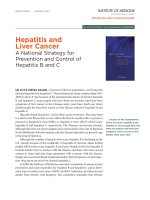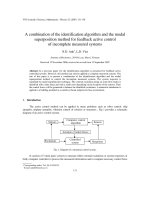Fractional order adaptive kalman filter for sensorless speed control of dc motor
Bạn đang xem bản rút gọn của tài liệu. Xem và tải ngay bản đầy đủ của tài liệu tại đây (6.31 MB, 19 trang )
International Journal of Electronics
ISSN: (Print) (Online) Journal homepage: www.tandfonline.com/journals/tetn20
Fractional order adaptive Kalman filter for
sensorless speed control of DC motor
Ravi Pratap Tripathi, Ashutosh Kumar Singh & Pavan Gangwar
To cite this article: Ravi Pratap Tripathi, Ashutosh Kumar Singh & Pavan Gangwar (2023)
Fractional order adaptive Kalman filter for sensorless speed control of DC motor, International
Journal of Electronics, 110:2, 373-390, DOI: 10.1080/00207217.2021.2025452
To link to this article: />
Published online: 05 Feb 2022.
Submit your article to this journal
Article views: 278
View related articles
View Crossmark data
Citing articles: 1 View citing articles
Full Terms & Conditions of access and use can be found at
/>
INTERNATIONAL JOURNAL OF ELECTRONICS
2023, VOL. 110, NO. 2, 373–390
/>
Fractional order adaptive Kalman filter for sensorless speed
control of DC motor
Ravi Pratap Tripathi , Ashutosh Kumar Singh and Pavan Gangwar
Electronics and Communication Engineering Department, Indian Institute of Information Technology
Allahabad, Prayagraj, India
ABSTRACT ARTICLE HISTORY
Received 31 July 2021
State estimation is a challenging and most crucial issue in the Accepted 5 December 2021
industry for proper monitoring and controlling of the plants.
These kinds of control systems have the requirement of costly KEYWORDS
measurement sensors/equipment for measurable and unmeasur DC motor; Kalman filter;
able state variables of the dynamical plants. These drawbacks can fractional calculus; sensorless
be overcome by designing a sensorless system to estimate the state control
variables. In the proposed work, sensorless speed control of DC
motor is implemented by using a fractional-order adaptive Kalman
filter (FOAKF). The FOAKF algorithm uses a fractional feedback loop
of the previous Kalman gain along with the current Kalman gain.
The motor shaft speed is estimated by the FOAKF state estimator.
Furthermore, a performance comparison of extended Kalman filter
(EKF) and FOAKF estimator under a similar condition is realised
using MATLAB/Simulink environment. To validate the performance
of the FOAKF estimator, a hardware prototype model has been
presented with the help of the arduino board. In the proposed
work, the root-mean-square error (RMSE) and Euclidean distance
error between reference speed and estimated speed have been
used for the performance metric. The performance comparison
result shows that FOAKF is a more robust and accurate state esti
mator in comparison with EKF.
1. Introduction
In all industrial work, mechanical movement is carried out with the use of electric motors,
hydraulics and pneumatic systems. To drive these systems, motors are required. For motion
transmission systems generally, AC motors are used while DC motors are used in robotic
manipulators and in industrial applications, where high load torque is needed. To imple
ment the industrial task, various control approaches are used, in general emphasis is given
to controlling the speed of the machines. To achieve effective speed control, a closed-loop
control system is used, in which motor state variables like current, position and rotor speed
are feedbacked. A suitable controller can be implemented when all the state variables of the
system are known. To measure the entire state variable, it uses various sensors; thereby cost
increases and makes the system more complex. To reduce the number of sensors, hardware
complexity and system cost, state observers/estimators are used in the control loops of
CONTACT Ravi Pratap Tripathi ; Indian Institute of Information Technology Allahabad,
Prayagraj, Uttar Pradesh, India
© 2022 Informa UK Limited, trading as Taylor & Francis Group
374 R. P. TRIPATHI ET AL.
electrical motors (Jang et al., 2003; Mohan et al., 2020). The advantages of state observers
over sensors are that they are not affected by any environmental causes and any machine
distortions (Wang et al., 2019). Some sensorless speed control methods were performed
(Lascu et al., 2006; Raca et al., 2008). An observer is a mathematical tool that estimates states
with the help of system dynamical models and some measured state variables.
Some works have been presented in previously published literature in which sensors
are not mounted on the motor shaft and stochastic observer/estimator are used to
estimate the speed of the DC motor. In the previous works, the state estimation was
performed by using the sliding mode observer (Lascu et al., 2009; Qiao et al., 2013) Kalman
Filter (KF) (Rigatos, 2009), Extended Kalman Filter (EKF; Boizot & Busvelle, 2007; Terzic &
Jadric, 2001; E. Zerdali, 2019) and the particle filter (Ristic et al., 2004).
KF is an elementary concept and an extensively used mathematical tool for state
estimation. KF is applicable only for linear systems and gaussian noise. In a nonlinear
dynamic system generally, EKF is used (O. Aydogmus & Talu, 2012; Z. Aydogmus &
Aydogmus, 2015; Habibullah & Lu, 2015; Tiwari et al., 2017; Yin et al., 2019; Zhou et al.,
2016). EKF is applicable only when the system is differentiable, well defined, noises are
gaussian and their covariance is known; otherwise, it starts diverging. In such cases, the
other versions of KF like UKF (Jafarzadeh et al., 2013), CDKF (Zhao et al., 2020), Adaptive
KF/EKF (Jiancheng & Sheng, 2011; Emrah Zerdali, 2020; ZhiWen et al., 2013) were pro
posed. In the open literature, EKF and its derivative-based sensorless speed control
algorithms are present but they could not able to provide sufficient contribution for
sensorless speed control when the system is diverging and not well defined. To incorpo
rate the above difficulties in state estimation FOAKF algorithm has been proposed. FOAKF
is a robust adaptive state estimation technique, which is more adaptive in the field of
signal and image processing, thermodynamics and tracking applications (Kaur & Sahambi,
2016). In the presented FOAKF algorithm, modified steady-state Kalman gain is proposed
that is obtained by inserting a fractional feedback loop of previous Kalman gain with
current steady-state Kalman gain. The main advantage of FOAKF is that its gain will never
be diverse because of the fractional derivative of the previous Kalman gain. The main
contribution of this work is to develop a MATLAB/Simulink model for analysing the
performance of the EKF and FOAKF estimator at nonlinear load in the closed-loop
sensorless speed control. Furthermore, a simulink model and its experimental validation
have been presented of a FOAKF estimator-based sensorless speed control mechanism for
DC motor at nonlinear and sudden load conditions.
The paper is organised in the following sections: In section 2, a DC motor mathematical
model has been presented. The state estimation algorithm is presented in section 3. In
section 4, a stability analysis of the FOAKF estimator has been discussed. The simulation
and experimental results are described in section 5 and at last, the concluding remarks are
presented in section 6.
2. DC motor mathematical model
DC motor mathematical model in the time domain form is required for state estimation
algorithm. The DC motor model has two main equations, one is electrical and the other
one is mechanical (Kothari & Nagrath, 2010). On applying Kirchhoff’s law in the armature
circuit shown in Figure 1(a), the electrical equation is given as:
INTERNATIONAL JOURNAL OF ELECTRONICS 375
Figure 1. DC motor circuit diagram and load model. (a) Circuit diagram of DC motor (b) Nonlinear load
model.
d
vtị ẳ eatị ỵ Raiatị ỵ La iaðtÞ (1)
dt
where Ra is armature resistance, ia is armature current, La is the self-inductance produced
by the armature flux, vt is armature supply voltage, and ðeaðtÞ ¼ Keif ωmÞ is back emf.
A separately excited DC motor is shown in Figure 1(a), which requires an extra DC voltage
vf to produce a magnetic field. Rf and Lf represent the resistance and inductance of the
field winding respectively. It is well known, when vf constant and steady-state exists on
the field circuit, then if (field current) is constant, therefore Equation (1) can be written as:
vtị ẳ K0emtị ỵ Raiatị ỵ La d iaðtÞ (2)
dt
For motoring operation, the dynamic equation for the mechanical system is
d
Ttị ẳ Ktif tịiatị ẳ J mtị ỵ TLtị ỵ Tf tị ỵ Dmtị (3)
dt
where J is moment of inertia of motor and load, ωm is the motor speed, D viscous
damping coefficient, Tf ðtÞ and TL is coulomb friction torque and load torque, respectively.
The load torque is shown in Figure 1(b) and can be mathematically written as:
TL ẳ mgL cos ỵ mL2 d ωmðtÞ (4)
dt
where L is arm length, m is the mass of load, g is gravitational constant and θ is angular
displacement (integral of ωm).
As if constant, then Equation (3) can be written as:
Ttị ẳ K0tiatị ẳ J d mtị þ TLðtÞ þ Tf ðtÞ þ DωmðtÞ (5)
dt
376 R. P. TRIPATHI ET AL.
With the help of Equations (2) and (5), the state-space model can be implemented. The
model comprises two state variables armature current (ia) and motor speed (ωm). The
state-space model of DC motor in the time domain is given as:
� � "D K0 # t � � " mgL cos θÀ Tf #� �
ω_ m mL2ỵJ mL2ỵJ m 01
¼ À K0t ỵ mL2 ỵJ (6)
_ À Ra À Ra
ia La La ia 0 La vt
From the state-space model, θ produces nonlinearity in the system. For digital implemen
tation, the above Equation (6) must be discretised. The discrete-time model of the above
system is represented by equations given below:
xkỵ1 ẳ Adxk ỵ Bduk ỵ vk (7)
yk ẳ Cdxk ỵ wk (8)
In the above equation, state variable x ¼ ½ωm ia� t, input vector u ¼ ½1 vt�t, and output
vector y ẳ ẵ0 iat whereas v (mean 0, covariance Q) and w (mean 0, covariance R) are the
process noise, and measurement noise, respectively. After putting the motor parameters
value given in Appendix in Equation (6), the discretised matrix coefficients Ad; Bd and Cd
at sampling interval ðTsÞ can be written as:
� �
Ad ¼ I þ ATs ¼ 1 0:005 À 0:007 0:9828 (9)
� �
Bd ¼ BTs ¼ À 0:016 0 0 0:0067 (10)
Cd ¼ C ¼ ½ 0 1 � (11)
With the help of controllability c ẳ ẵBd AdBd ị and observability O ẳ ẵCd AdCdt ị test,
we find that c and O are full rank (n = 2) matrix, which implies that we can design
a controller and observer. The details of EKF and FOAKF observer and their performance
comparison are present in the next sections.
3. State estimation algorithm
The state-space model obtained in section 2 is used by the EKF and FOAKF algorithm to
estimate the motor speed ðωmÞ and armature current ðiaÞ from the measurement ia.
3.1. EKF algorithm
KF is a state estimator that uses an iterative mathematical equation to compute the best
possible state from the noisy state. The KF is not applicable for the nonlinear system, as in
the calculation of θ using ωm leads the DC motor model to nonlinear, so EKF is used to
overcome this difficulty. EKF is the extended version of KF that uses first-order Taylor
series approximation of nonlinear dynamical function to estimate the state by noisy
measured data. The EKF has two main steps one is state prediction and the other one is
state correction. In the prediction step, a dynamical model of the system with process
INTERNATIONAL JOURNAL OF ELECTRONICS 377
noise covariance Q is used. In the correction, the predicted state is corrected with the help
of continuously measured data and Kalman gain ðKÞ. However in the application of EKF,
the system dynamical model and initial values of all the covariance matrices, namely, Q; R
and P must be known accurately. If these are not defined correctly then the system may
become unstable and can diverge. The standard EKF estimation has a two-step process,
one is prediction and the other one is corrections, which are presented below.
The prediction step is
^xkỵ1=k ẳ f ð^xk; ukÞ (12)
Pkỵ1=k ẳ AdPkAtd þ Q (13)
^xkỵ1=k is predicated state of xkỵ1.
The correction step is
Kkỵ1 ẳ Pkỵ1=kCdt CdPkỵ1=kCdt ỵ Rị 1 (14)
^xkỵ1 ẳ ^xkỵ1=k ỵ Kkỵ1ykỵ1 Cd^xkỵ1=kị (15)
Pkỵ1 ẳ Pkỵ1=kI Kkỵ1Cdị (16)
^x0kỵ1 is the updated states, I is the identity matrix and Kkỵ1 is Kalman gain. Equations (12)-
(16) are one complete cycle of the EKF algorithm.
3.2. FOAKF algorithm
The mathematical model of the system is nonlinear, and generally, the system model and
their covariance Q; R and P are not normally well defined. Therefore, the other adaptive
state estimation algorithm known as FOAKF has been presented in this section.
The main concept behind FOAKF is to introduce a fractional derivative of previous
Kalman gain as feedback in the Kalman gain loop. Grunawald-Letnikov’s definition
(Sierociuk & Dzieliński, 2006) has been used for the computation of fractional feedback
Kalman gain in the proposed technique. Based on Grunawald-Letnikov definition, the
fractional difference of signal xk can be given as:
α 1 Xk j
xk ẳ 1ị jxk j (17)
h j¼0
α is fractional order ð0 < α < 1ÞÞ, k number of samples in signal xk, h (Sampling interval = 1).
In the proposed work, for all the simulation we assume α ¼ 0:5 because if we take α close
to zero then the time taken to stabilising xk will be more and for α close to one it takes less
time to stabilise. The γj (gamma function) can be given as:
� 1ị......:: jỵ1ị �
α for j>0
γj ¼ ¼ j
j
1 for j ¼ 0
The FOAKF gain is calculated by using fractional calculus. For calculating FOAKF gain,
following step has been used as given below:
378 R. P. TRIPATHI ET AL.
Figure 2. Control strategy of sensorless speed control of DC motor.
(1) Calculate standard Kalman gain Kkỵ1ị.
(2) Calculate fractional difference gain ðfkÞ of prior standard Kalman gain.
(3) FOAKF gain is the algebraic sum of fractional difference gain and standard Kalman
gain.
It is well known that the working of EKF is a two-step process. The first step of EKF is
prediction while the second step is correction. Similar to EKF, FOAKF is also a two-step
process which is given below:
Predicted state of Equations (7) and (8) is:
^xkỵ1=k ẳ Ad^xk ỵ Bduk (18)
Pkỵ1=k ẳ AdPkAtd ỵ Q (19)
In the correction step, first calculate standard Kalman gain Kkỵ1ị using Equation (14).
Applying the theory of fractional calculus presented in Equation (17) on prior Kalman gain
ðKkÞ the fractional difference gain ðfkÞ can be calculated as:
(Xk )
fk ẳ E 1ịjỵ1jKk j (20)
j¼0
fk presented in Equation (20) is the mean of the fractional derivative of the prior Kalman
gain. The proposed FOAKF gain ðKmodÞ is given by adding Equations (14) and (20).
Kmod ẳ Kkỵ1 ỵ fk (21)
Now the corrected, states and error covariance of discrete time system can be calculated
similarly as Equations (15) and (16) using Kmod, which are given below:
^xkỵ1 ẳ ^xkỵ1=k ỵ Kmodykỵ1 Cd^xkỵ1=kị (22)
Pkỵ1 ẳ Pkỵ1=kI KmodCdị (23)
Equations (18)-(23) are the one complete cycle of the FOAKF algorithm. The FOAKF gain
ðKmodÞ can be calculated by minimising the error covariance Pkỵ1:
INTERNATIONAL JOURNAL OF ELECTRONICS 379
Figure 3. Detailed simulink model of the system. (a) EKF and FOAKF block (b) DC motor model.
n o
Pkỵ1 ẳ E xkỵ1 ^xkỵ1ị2
(24)
nÀ À 2o
Pkỵ1 ẳ E xkỵ1 ^x0kỵ1=k Kkỵ1 ỵ fkị ykỵ1 Cd^x0kỵ1=k (25)
For minimising the Pkỵ1 put @Pkỵ1 ẳ 0, and after solving we get FOAKF gain ðKmodÞ:
@K
( Xk )
Kmod ẳ Kk ỵ E 1ịjỵ1jKk j (26)
j¼0
380 R. P. TRIPATHI ET AL.
4. Stability analysis
For FOAKF estimator stability analysis, the error between the actual state ðxkÞ and the
estimated state ð^xkÞ should be considered. Because if error reaches zero, then ^xk will reach
to xk. The dynamics of the xk and ^xk are given in Equations (7) and (23), respectively. Now
the error ðeÞ and its derivatives ðe_Þ can be given as:
e ¼ xk À ^xk (27)
e_ ẳ Axk ỵ Buị A^xk ỵ Bu ỵ KmodCxk C^x0kị
(28)
¼ ðA À KmodCÞe
Equation (28) will be stable only if ðA À KmodCÞ is hurwitz matrix. If it is hurwitz then ^xk will
keep becoming a better estimation of xk as time goes on and the system become stable.
Therefore to prove stability, a Lyapunov function can be considered as:
Veị ẳ e0Pe (29)
V_ eị ẳ e0Pe_ ỵ e_0Pe (30)
V_ eị ẳ e0PA KmodCịe ỵ e0A KmodCị0Pe (31)
V_ eị ẳ e0PA0 ỵ AP 2KmodCPịe (32)
According to Lyapunov stability concept for asymptotic stability, V_ ðeÞ < 0 and using the
riccati equation given in (Aminifar, 2016):
PA0 ỵ AP KmodCP ỵ B0B ẳ 0 (33)
Therefore, Equation (32) can be written as
PA0 ỵ AP 2KmodCP ¼ À B0B À KmodHP (34)
Now substitute the Equation (34) value into Equation (32), V_ ðeÞ will be:
V_ eị ẳ e0B0B ỵ KmodHPịe (35)
From Equation (35), it is clear that VðeÞ will be a valid quadratic Lyapunov of Equation (29),
which implies that the corresponding matrix must be hurwitz.
5. Simulation and experimental results
The block diagram of the sensorless speed control strategy is shown in Figure 2. In the
block diagram, a PI controller, motor driver, DC motor and a FOAKF state estimator are
present. The FOAKF state estimator estimates the speed, which is feedbacked to perform
the sensorless speed control of the DC motor.
INTERNATIONAL JOURNAL OF ELECTRONICS 381
Figure 4. Performance comparison of EKF and FOAKF estimator at variable load
ðTL ¼ mgL cos ỵ mL2 dt dmị. (a) Speed estimations result and actual motor shaft speed (b) Current
estimations result and measured current speed (c) Euclidean distance speed estimation error of EKF
and FOAKF (d) Root mean square error of EKF and FOAKF (e) Load torque.
5.1. Simulation results
A sensorless PI-based speed control system is built using Simulink/MATLAB code
generator to compare the EKF and FOAKF performance. The detailed MATLAB simu
link structure of the system is shown in Figure 3. The Simulink structure has two
382 R. P. TRIPATHI ET AL.
modules, ‘module-1’ and ‘module-2’. Module-1 consists of a PI controller for speed
and current, a PWM generator, EKF, and FOAKF algorithms. The sampling interval of
module-1 is 200 µs. Module-2 has a separately excited DC motor and an H-bridge
built by four IGBT using MATLAB/Simscape toolbox. A PWM-controlled H-bridge is
used to drive the DC motor as shown in module-2. The sampling interval of module-
2 is 1 µs. In this work, armature current ðiaÞ of the DC motor is a known or measured
state variable, which is used for estimating the other states using EKF and FOAKF
algorithms. In a real-time application, armature current ðiaÞ is calculated by the use of
a current transducer with machine noise, A/D quantisation noise and measurement
inaccuracy. Therefore in simulation, armature current is obtained by adding white
gaussian noise. In the controller block shown in Figure 3, the current and speed PI
controller is used. The parameter of speed PI controller are kps ¼ 10 and kis ¼ 0:5,
current controller parameters are kpc ¼ 100 and kic ¼ 10.
5.1.1. Comparison of EKF and FOAKF estimator
To compare the EKF and FOAKF estimator performance, the manual switch presents
in Figure 3 is connected to work-1. In a real-time application, the exact parameters of
the motor cannot be perfectly known, therefore to perform simulation gaussian noise
INTERNATIONAL JOURNAL OF ELECTRONICS 383
is added to the motor shaft speed ðωacÞ. The obtained ωac is used for closed-loop
speed control and to carry out the performance comparison between EKF and FOAKF
estimator for constant reference speed ðωref ¼ 50 rad= secÞ tracking. The speed and
current estimation results of the EKF and FOAKF estimator at variable load are shown
in Figure 4(a,b), respectively. From Figure 4(a), it can be stated that the estimated
speed by FOAKF is closer to ωref in comparison with EKF, i.e. the tracking capability
of ωref is better by FOAKF estimator. In Figure 4(c,d), the Euclidean distance speed
estimation error and root-mean-square error (RMSE) between the estimated motor
speed and reference speed is shown. The average Euclidean estimation error is
obtained by subtracting the corresponding value of estimated speed and reference
speed. RMSE is the root-mean-square error between a reference speed and estimated
speed, over a range of observations. The RMSE is obtained with the help of the RMS
block present in the simulink library. From Figure 4(c,d), it can be observed that
FOAKF has the better error (nearer to zero is better) response in comparison with the
EKF estimator.
5.1.2. Speed control with FOAKF estimator
In the second work, the DC motor speed control is performed by FOAKF-based
speed estimation technique. The FOAKF estimated speed is used for the closed-
loop speed control mechanism. The simulink model for the present work is similar
to the same model used in section 5.1; the only difference is the manual switch has
been connected to work-2 in the place of work-1. In work-2, the FOAKF estimated
shaft speed ðωfoakf Þ is used in closed-loop control to perform the sensorless con
stant speed control. The FOAKF-based sensorless closed-loop speed control perfor
mances are shown in Figure 5 at the same load condition as used in section 5.1.1.
The speed and current estimation results are presented in Figure 5(a,b), respec
tively. In Figure 5(a), the FOAKF estimated speed and actual motor shaft speed
(controller shaft speed) are shown. From Figure 5(a), it can be observed that the
actual shaft speed and FOAKF estimated shaft speed both track the reference
speed very quickly and produce minimum transient. On comparing the results
obtained in Figures 4 (a) with 5(a), it can be stated that the FOAKF based speed
controller has better overshoot, settling time and it has very good ωref tracking
ability. In Figure 5(b), the FOAKF estimated armature current and measured arma
ture current are shown. On comparing the results obtained in Figures 4(b) to 5(b),
we are finding that FOAKF based estimation method takes less current for the
same load torque. In Figure 5(c,d), the average Euclidean error and RMSE error
between reference speed and FOAKF estimated speed is present. In the perusal of
this, it can be observed that the obtained error by the FOAKF estimator is closer to
zero; therefore, it can be said that FOAKF has a better error response.
To check the robustness of the FOAKF estimator, the variable load is replaced by
a sudden load of 20 N À m and reference speed is varied from 50 rad= sec to
130 rad= sec . To create a sudden load in the simulink environment, a step function
is used with step value 20 at t = 0.5 sec. The performance of the FOAKF estimator
at sudden load is shown in Figure 6. In Figure 6(a), the speed estimation perfor
mance is shown. From this Figure, it can be observed that when there is no load,
then after some momentary oscillation FOAKF estimator estimates the reference
384 R. P. TRIPATHI ET AL.
Figure 5. Simulation results of DC motor using FOAKF estimator for nonlinear load
ðTL ¼ mgL cos ỵ mL2 dt dmị. a) Closed-loop speed control of DC motor using FOAKF (b) Armature
current (c) Euclidean distance speed estimation error (d) Root mean square error.
INTERNATIONAL JOURNAL OF ELECTRONICS 385
Figure 6. Simulation results of DC motor using FOAKF estimator for sudden constant load
ðTL ¼ 20 N À mÞ. (a) Closed-loop speed control of DC motor using FOAKF (b) Armature current (c)
Step load torque.
386 R. P. TRIPATHI ET AL.
Figure 7. Hardware in loop system design. (a) Schematic of hardware in loop system design (b)
Arduino model for experimental setup interfacing.
speed perfectly before the EKF estimator. At t = 0.5 sec, load torque is changed
from 0 to 20 N- m. From Figure 6(a), it can be observed that as the load changes (0
to 20 N-m), the estimated speed by FOAKF and EKF estimator deviates slightly. But
after some transient, the FOAKF estimator again starts tracking to reference speed,
while EKF does not. From the discussion of the above results, we can state that
FOAKF-based sensorless speed controller has better overshoot and settling time
and it has very good reference tracking ability along with any load condition.
5.2. Experimental validation
To validate FOAKF-based sensorless speed control performance experimentally,
a hardware prototype model has been designed. The schematic of the hardware
in loop (HIL) configuration, Arduino communication setup for HIL simulation, and
INTERNATIONAL JOURNAL OF ELECTRONICS 387
Figure 8. Experimental setup of sensorless speed control of DC motor.
its experimental setup is shown in Figures 7 and 8, respectively. The experimental
setup consists of four major components, which are a motor with a voltage and
current sensor, motor driver module, PWM inbuilt Arduino board, and Personal
Computer (PC). To apply the load torque on the shaft, manual friction has been
provided. In PC, PI controller and FOAKF estimator are present. The armature
current and voltage across the motor winding are sensed by the voltage and
current sensor and read by the Arduino analog pin A1 and A2. This sensed value
is used to estimate the speed of the motor in the next iteration by the FOAKF
estimator. The difference between reference speed and estimated speed generates
the error signal for the controller block. The controller block generates the corre
sponding duty cycle, which is responsible for generating the PWM signal. The
generated PWM signal is applied to Arduino digital pin 9, to generate an appro
priate voltage with the help of the L298N motor driver to control the speed of the
DC motor.
The experimental results of the prototype with nonlinear load at constant and
variable speed have been given in Figures 9(a,b), respectively. From the figures, it
can be observed that the FOAKF estimator showing remarkable reference speed
tracking capability in both cases.
388 R. P. TRIPATHI ET AL.
Figure 9. Experimental results on constant and variable speed. (a) Experimental validation of FOAKF
estimator on constant speed (b) Experimental validation of FOAKF estimator on variable speed.
6. Conclusion
In this paper, EKF- and FOAKF-based sensorless speed control of DC motor have been
performed. The entire simulation test has been carried out at the same condition to
compare the state estimation performance. The result shows that EKF’s average Euclidean
estimation error and average RMSE are 0.9641 and 1.52, respectively, while FOAKF’s
average Euclidean estimation error and average RMSE are 0.5641 and 1.15, respectively.
The computational time of FOAKF is 23 µs and in EKF 19 µs. The computational complexity
of FOAKF is slightly greater than EKF because in FOAKF the effect of previous Kalman gain
is added by inserting the fractional feedback loop in the standard Kalman gain. However,
this amount of computational complexity does not create any problem because of
INTERNATIONAL JOURNAL OF ELECTRONICS 389
modern fast computational processors and GPU (graphics processing unit). The one more
advantage of FOAKF, it is derivative-free that makes it more suitable and adaptive for any
load variation.
In the second work, FOAKF-based closed-loop speed control has been performed. The
results of this work indicate that the sensorless speed control of DC motor using FOAKF
has better accuracy in comparison to EKF in all the cases. The result shows that FOAKF is
more robust and more stable for any low-speed application and load variation.
Disclosure statement
No potential conflict of interest was reported by the author(s).
ORCID
Ravi Pratap Tripathi />Ashutosh Kumar Singh />Pavan Gangwar />
References
Aminifar, A. (2016). Analysis, design, and optimization of embedded control systems. Linköping
Universityl.
Aydogmus, O., & Talu, M. F. (2012). Comparison of extended-Kalman- and particle-filter-based
sensorless speed control. IEEE Transactions on Instrumentation and Measurement, 61(2),
402–410. />
Aydogmus, Z., & Aydogmus, O. (2015). A comparison of artificial neural network and extended
Kalman filter based sensorless speed estimation. Measurement, 63, 152–158. /> 1016/j.measurement.2014.12.010
Boizot, N., & Busvelle, E. (2007). Adaptive-gain observers and applications. In: Gildas Besanỗon (Eds.),
Nonlinear observers and applications (pp. 71–114). Springer Berlin Heidelberg. /> 1007/978-3-540-73503-8_3
Habibullah, M., & Lu, D. D. (2015). A speed-sensorless FS-PTC of induction motors using extended
Kalman filters. IEEE Transactions on Industrial Electronics, 62(11), 6765–6778. /> 1109/TIE.2015.2442525
Jafarzadeh, S., Lascu, C., & Fadali, M. S. (2013). Square root unscented Kalman filters for state
estimation of induction motor drives. IEEE Transactions on Industry Applications, 49(1), 92–99.
/>
Jang, J.-H., Sul, S.-K., Ha, J.-I., Ide, K., & Sawamura, M. (2003). Sensorless drive of surface-mounted
permanent-magnet motor by high-frequency signal injection based on magnetic saliency. IEEE
Transactions on Industry Applications, 39(4), 1031–1039. />
Jiancheng, F., & Sheng, Y. (2011). Study on innovation adaptive EKF for in-flight alignment of
airborne POS. IEEE Transactions on Instrumentation and Measurement, 60(4), 1378–1388. https://
doi.org/10.1109/TIM.2010.2084710
Kaur, H., & Sahambi, J. S. (2016). Vehicle tracking in video using fractional feedback Kalman filter. IEEE
Transactions on Computational Imaging, 2(4), 550–561. />
Kothari, D. P., & Nagrath, I. J. (2010). Electric machine (Fourth ed.). Tata McGraw Hill.
Lascu, C., Boldea I., & Blaabjerg F. (2006). Comparative study of adaptive and inherently sensorless
observers for variable-speed induction-motor drives. IEEE Transactions on Industrial Electronics, 53
(1), 57–65. />
390 R. P. TRIPATHI ET AL.
Lascu, C., Boldea, I., & Blaabjerg, F. (2009). A class of speed-sensorless sliding-mode observers for
high-performance induction motor drives. IEEE Transactions on Industrial Electronics, 56(9),
3394–3403. />
Mohan, H., Pathak, M. K., & Dwivedi, S. K. (2020). Sensorless control of electric drives –
a technological review. IETE Technical Review, 37(5), 504–528. /> 2019.1662738
Qiao, Z., Shi, T., Wang, Y., Yan, Y., Xia, C., & He, X. (2013). New sliding-mode observer for position
sensorless control of permanent-magnet synchronous motor. IEEE Transactions on Industrial
Electronics, 60(2), 710–719. />
Raca, D., , P., Reigosa, D., Briz, F., & Lorenz, R. D. (2008). Carrier Signal Selection for Sensorless Control
of PM Synchronous Machines at Zero and Very Low Speeds.IEEE Industry Applications Society
Annual Meeting, Garcia, 2008, pp. 1–8 ,
Rigatos G. Gerasimos. (2009). Particle and Kalman filtering for state estimation and control of DC
motors, ISA Transactions, 48(1), 62–72. />
Ristic, B., Arulampalam, S., & Jordon, N. (2004). Beyond the Kalman filter: Particle filters for tracking
applications. Artech House.
Sierociuk, D., & Dzieliński, A. (2006). Fractional Kalman filter algorithm for states, parameters and
order of fractional system estimation. International Journal of Applied Mathematics and Computer
Science, 16(1), 129–140.
Terzic, B., & Jadric, M. (2001). Design and implementation of the extended Kalman filter for the speed
and rotor position estimation of brushless DC motor. IEEE Transactions on Industrial Electronics, 48
(6), 1065–1073. />
Tiwari, V., Das, S., & Pal, A. (2017). Sensorless speed control of induction motor drive using extended
Kalman filter observer. 2017 IEEE PES Asia-Pacific Power and Energy Engineering Conference
(APPEEC), IEEE, Bangalore, India, 1–6. />
Wang, Q., Wang, S., & Chen, C. (2019). Review of sensorless control techniques for PMSM drives. IEEJ
Transactions on Electrical and Electronic Engineering, 14(10), 1543–1552. /> tee.22974
Yin, Z., Li, G., Zhang, Y., & Liu, J. (2019). Symmetric-strong-tracking-extended-Kalman-filter-based
sensorless control of induction motor drives for modeling error reduction. IEEE Transactions on
Industrial Informatics, 15(2), 650–662. />
Zerdali, E. (2019). Adaptive extended Kalman filter for speed-sensorless control of induction motors.
IEEE Transactions on Energy Conversion, 34(2), 789–800. /> 2866383
Zerdali, E. (2020). A comparative study on adaptive EKF observers for state and parameter estima
tion of induction motor. IEEE Transactions on Energy Conversion, 35(3), 1443–1452. /> 10.1109/TEC.2020.2979850
Zhao, Q., Yang, Z., Sun, X., & Ding, Q. (2020). Speed-sensorless control system of a bearingless
induction motor based on iterative central difference Kalman filter. International Journal of
Electronics, 107(9), 1524–1542. />
ZhiWen, X., XiaoPing, H., & JunXiang, L. (2013). Robust innovation-based adaptive Kalman filter for
INS/GPS land navigation. 2013 Chinese Automation Congress, IEEE, Changsha, China, 374–379.
/>
Zhou, Y., Zhang, D., Chen, X., & Lin, Q. (2016). Sensorless direct torque control for saliency permanent
magnet brushless DC motors. IEEE Transactions on Energy Conversion, 31(2), 446–454. https://doi.
org/10.1109/TEC.2015.2505326
Appendix Motor and load parameter for simulation
Varmature ¼ 240V; Vfield ¼ 300V; Ra ¼ 2:581Ω; La ¼ 0:028H; Laf ¼ 0:9483H; J ¼ 0:02215kgm2; D
¼ 0:002953Nms; Tf ¼ 0:5161Nm; m ¼ 5kg; L ¼ 0:05m and g ¼ 9:81m=s2
